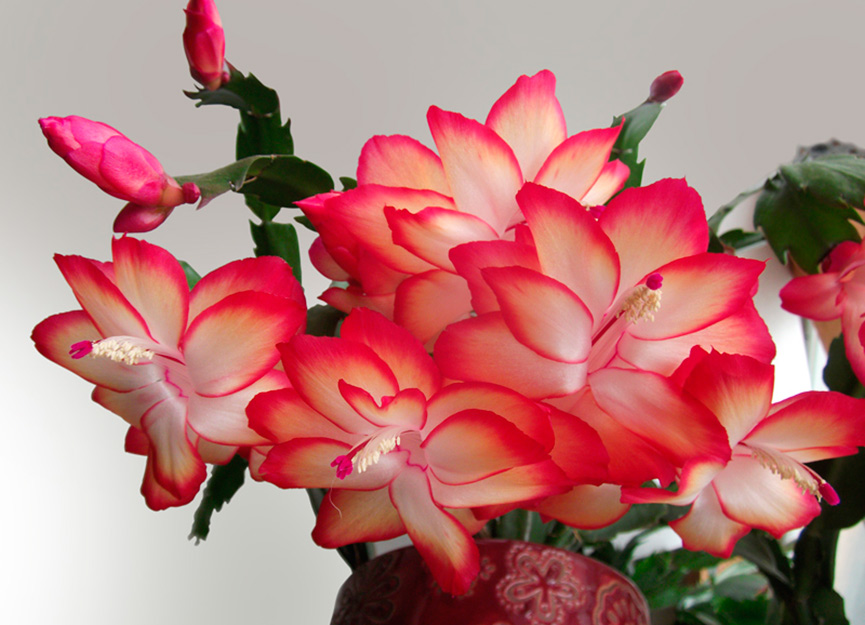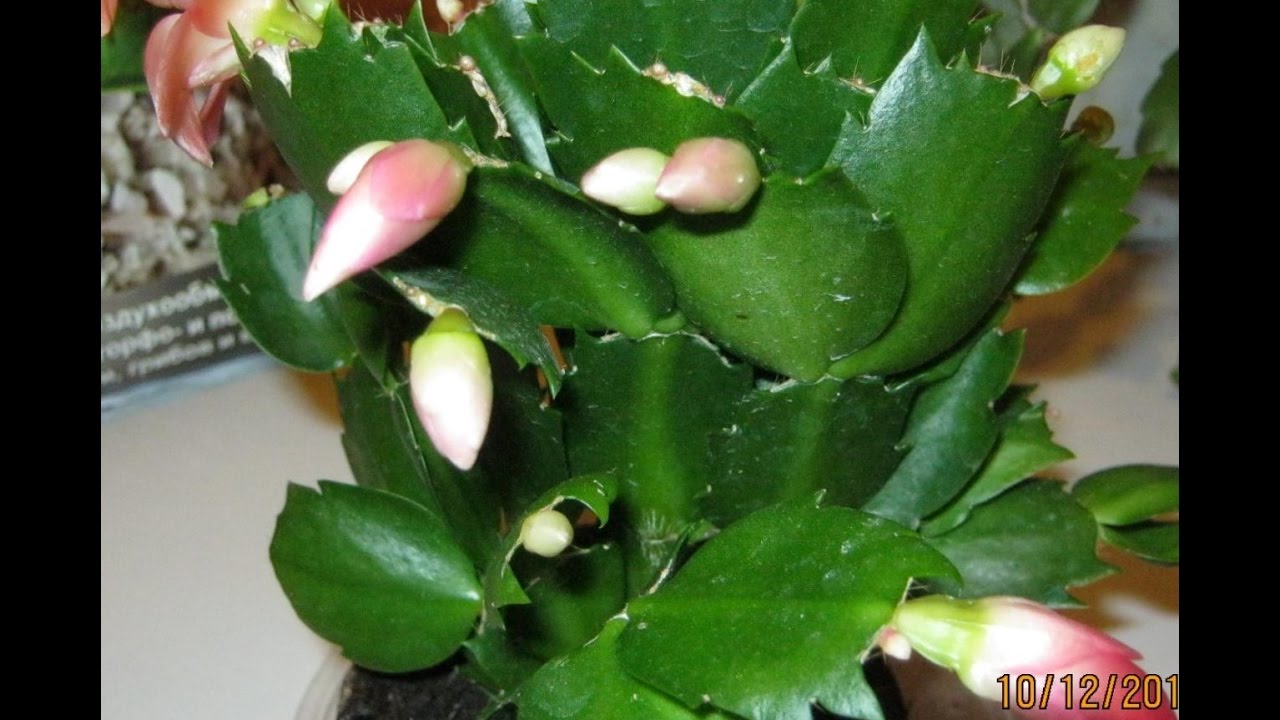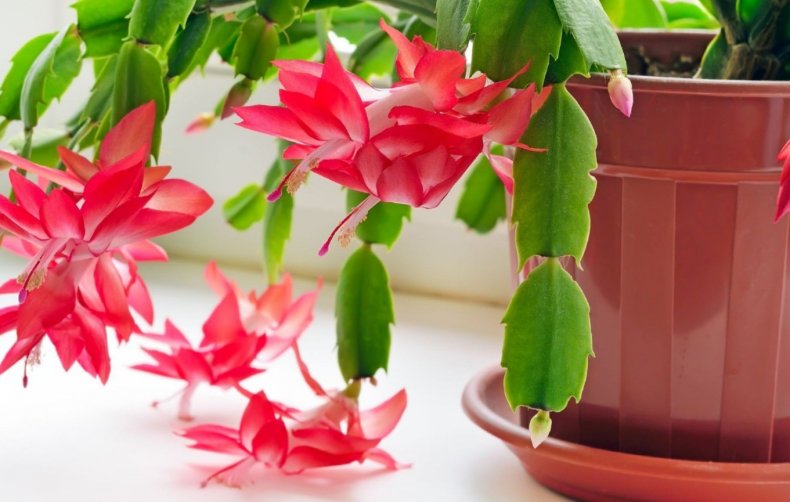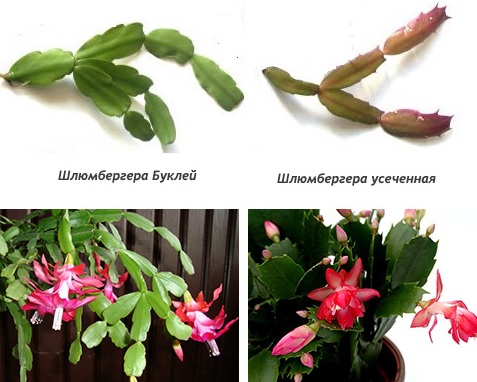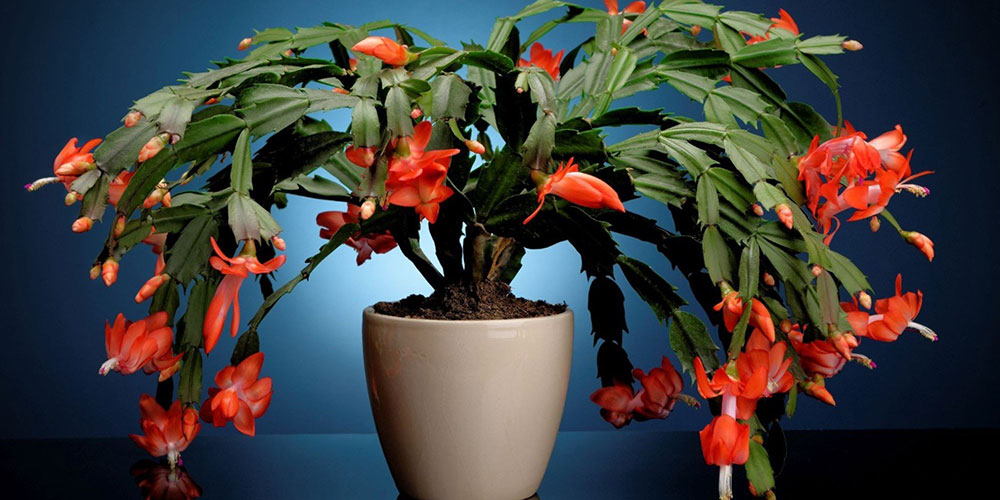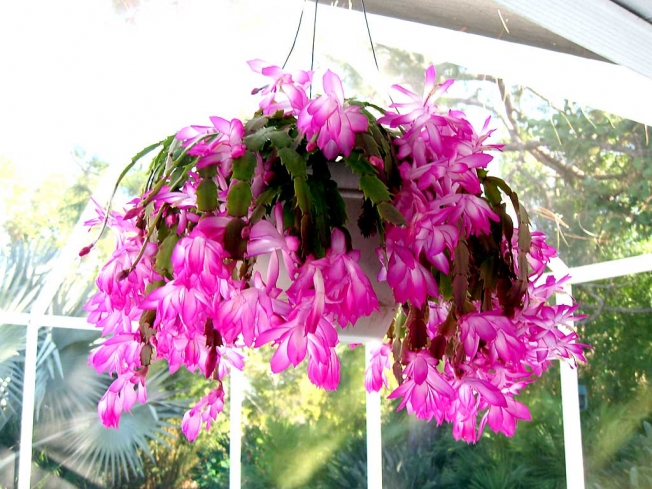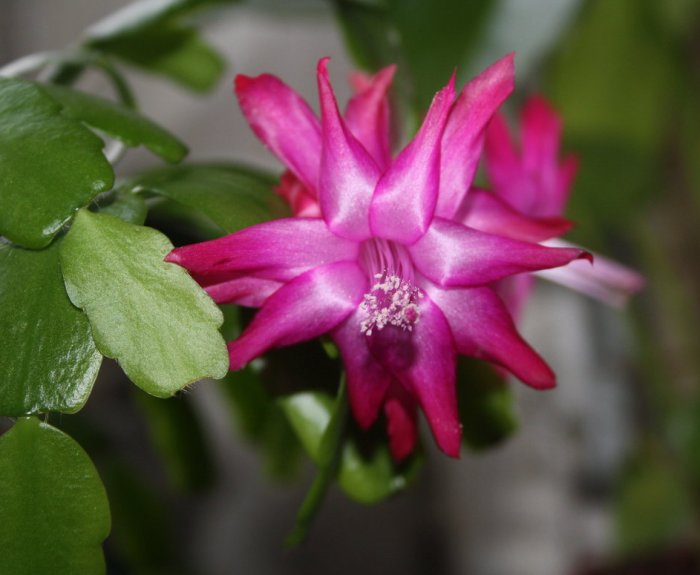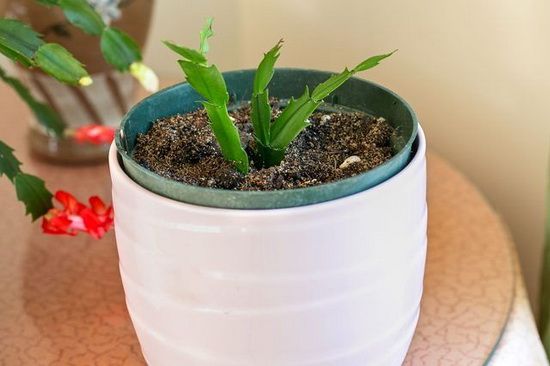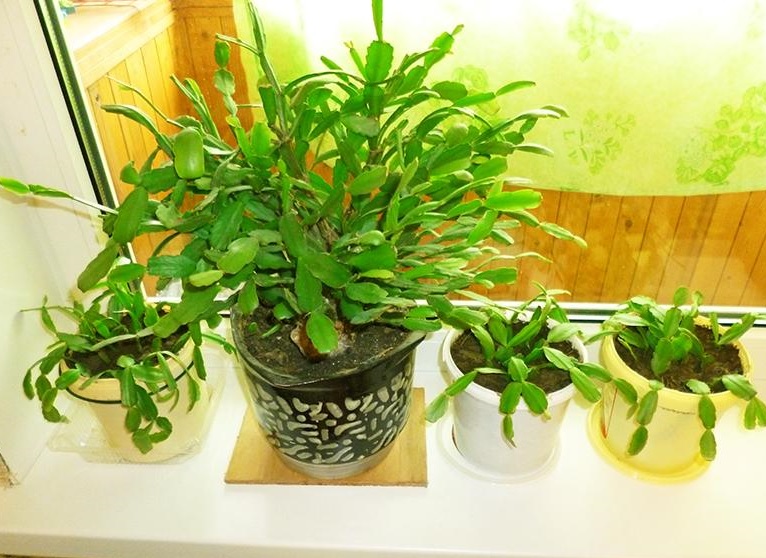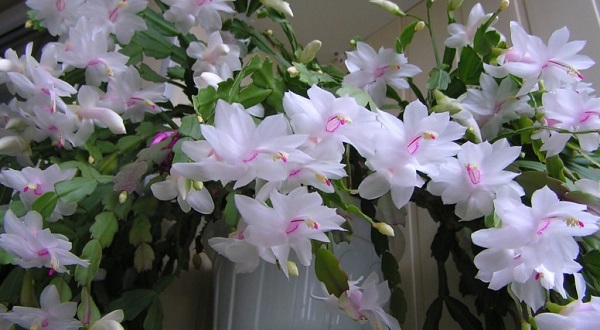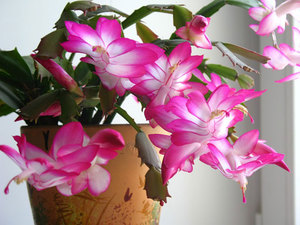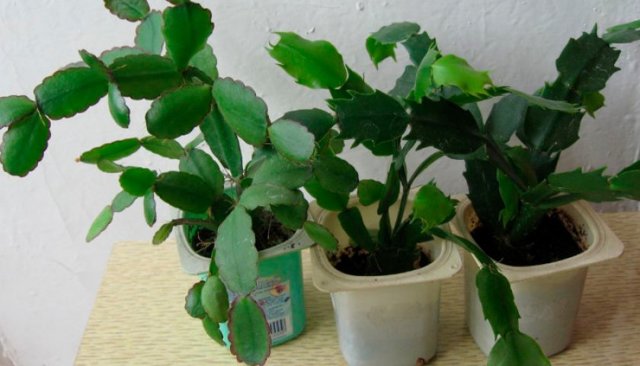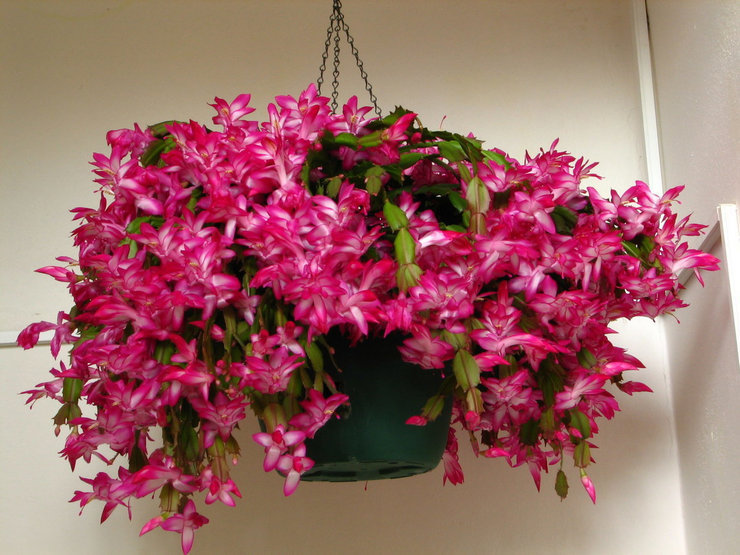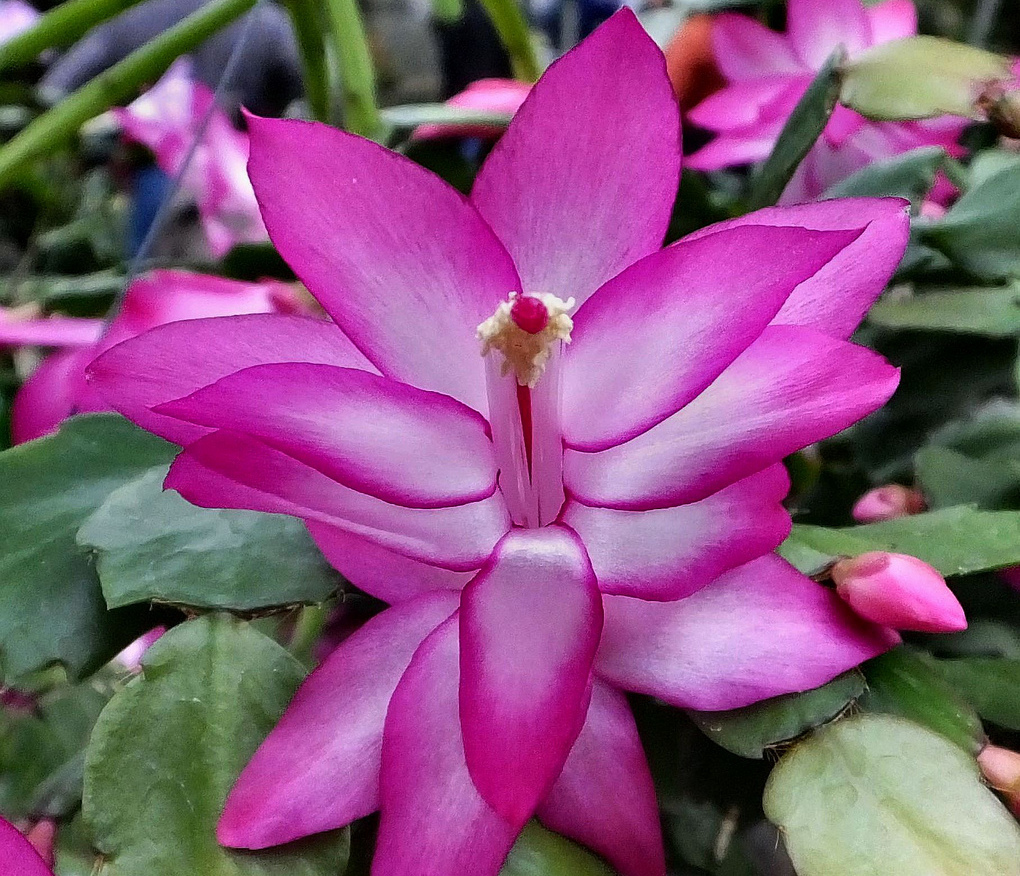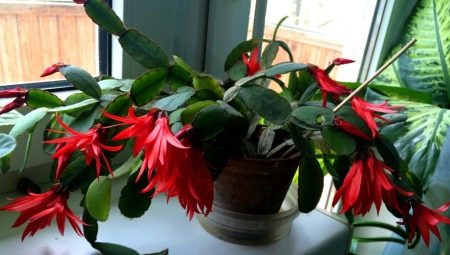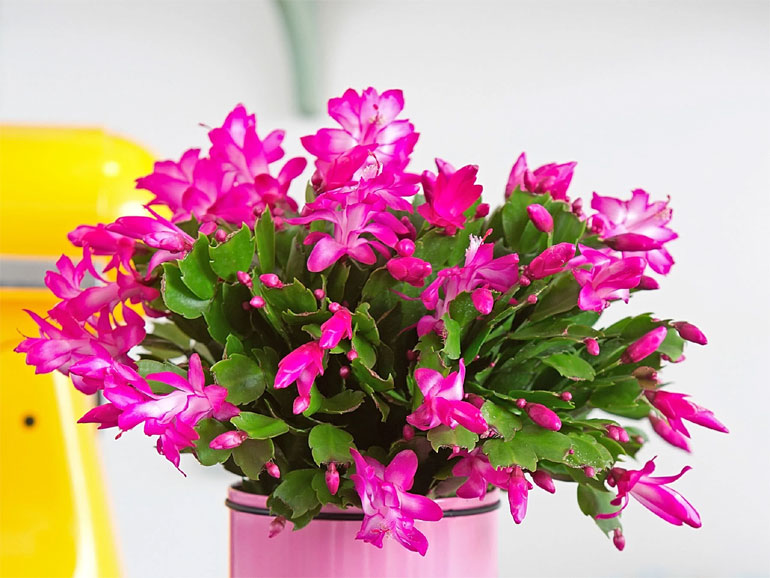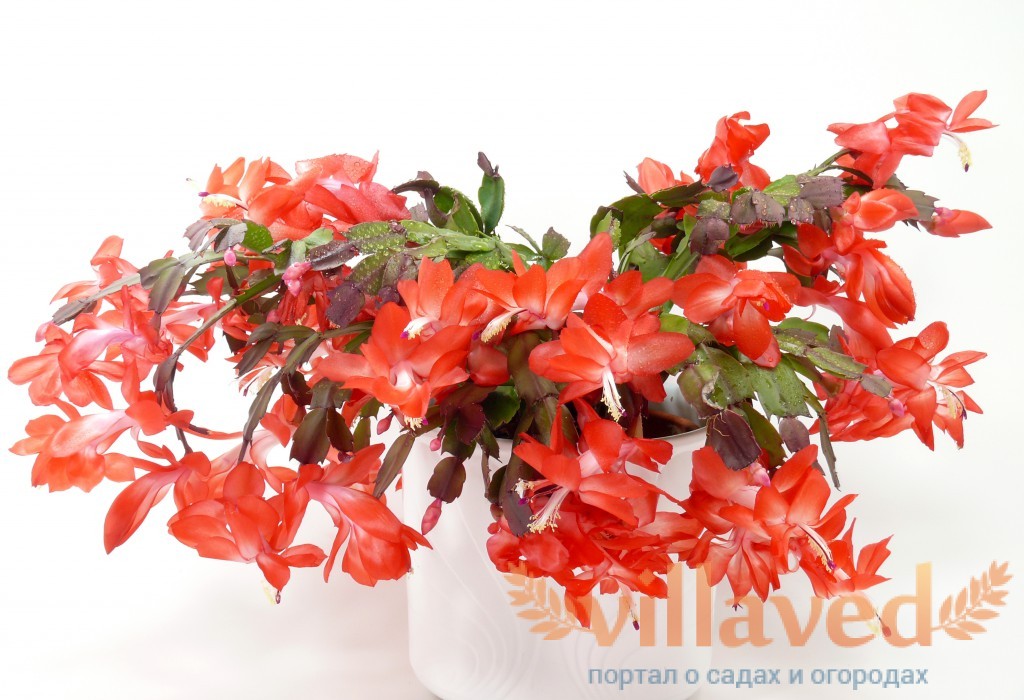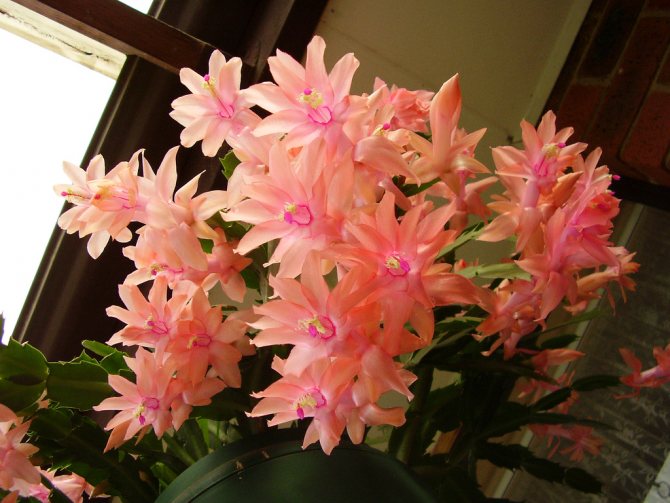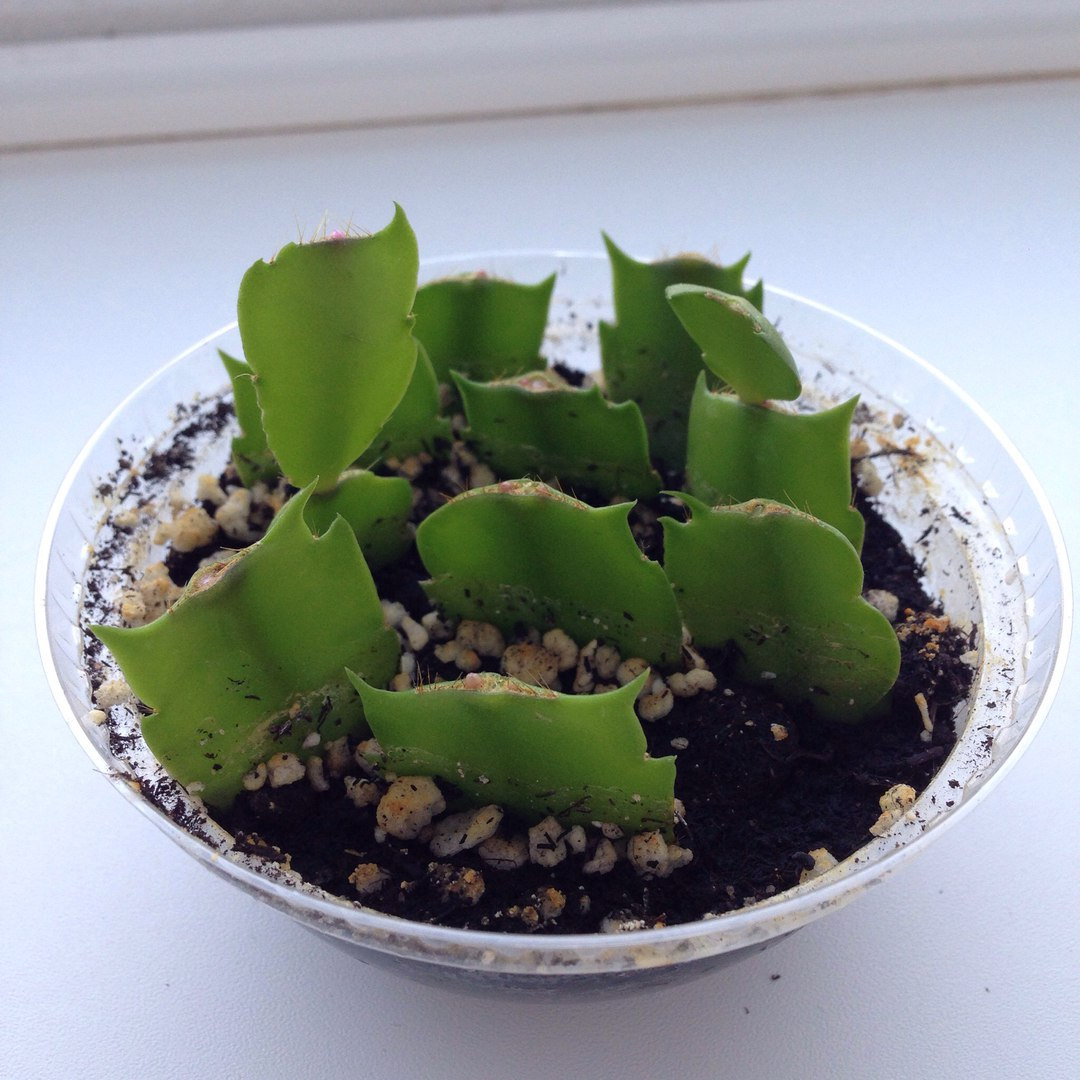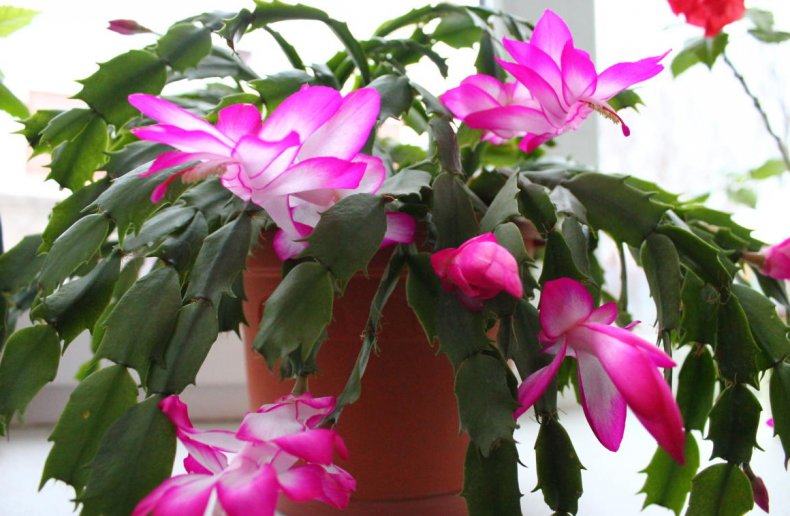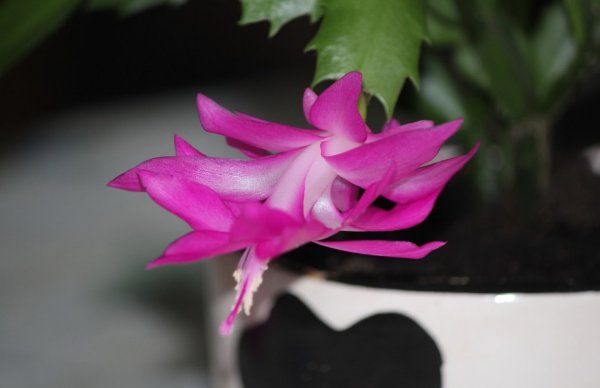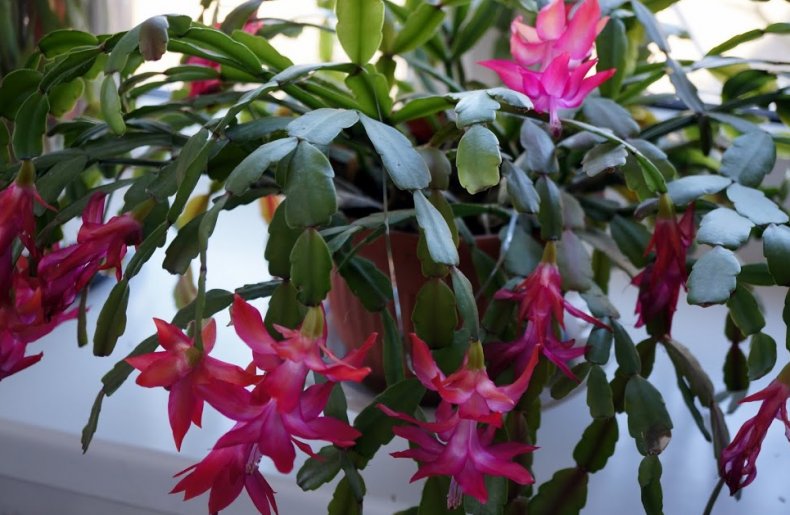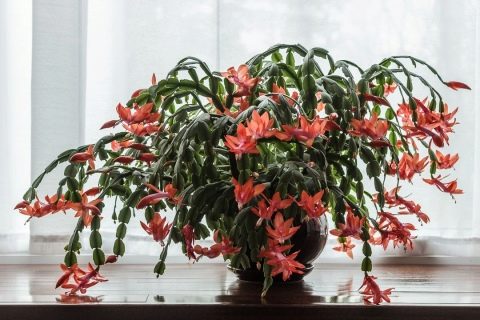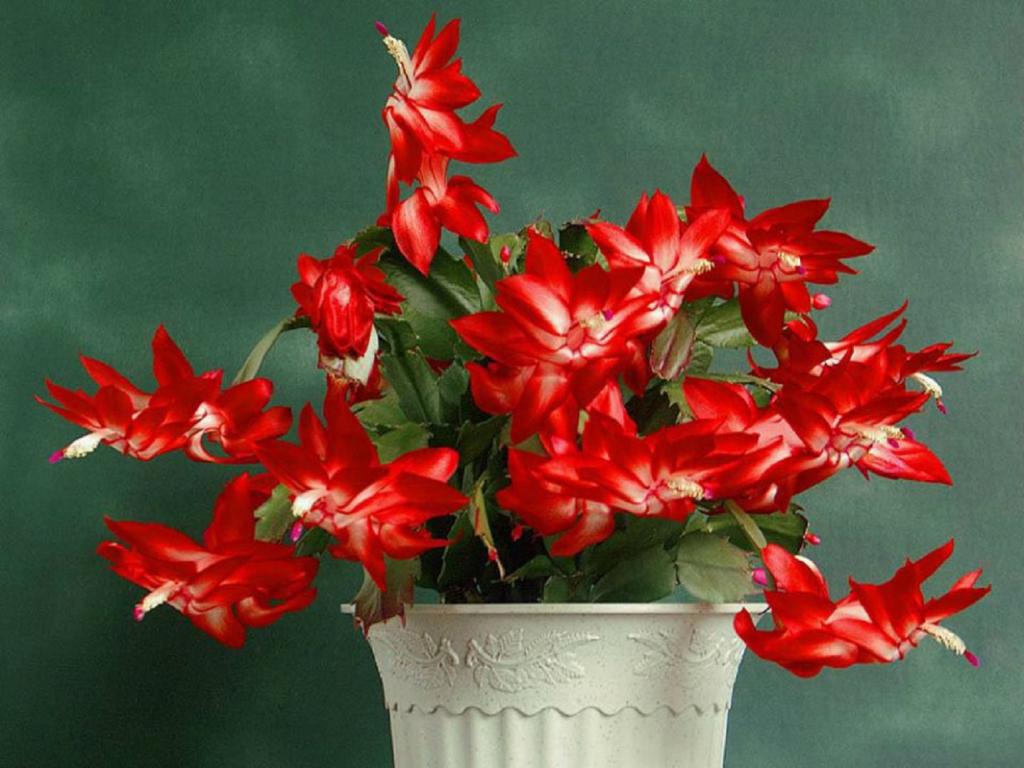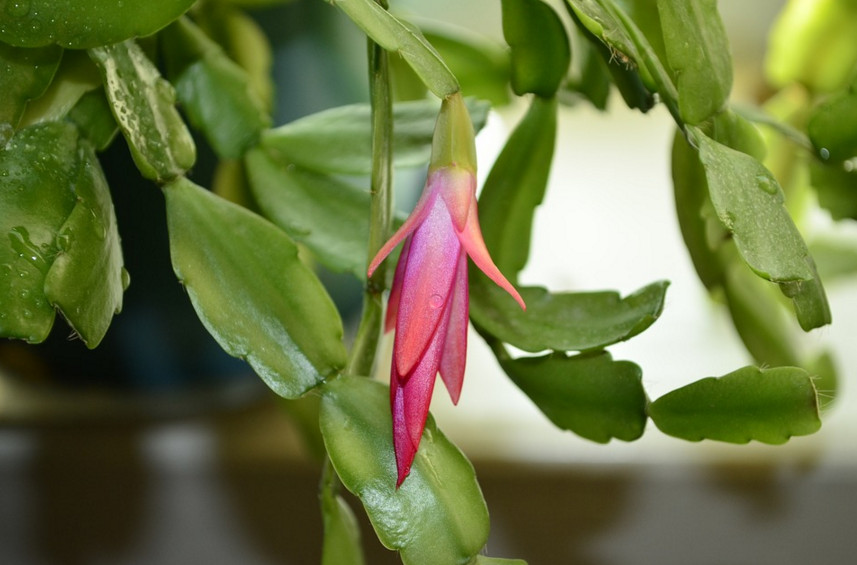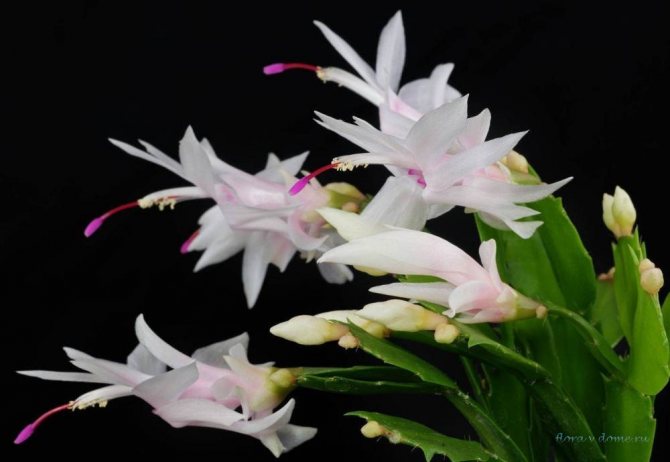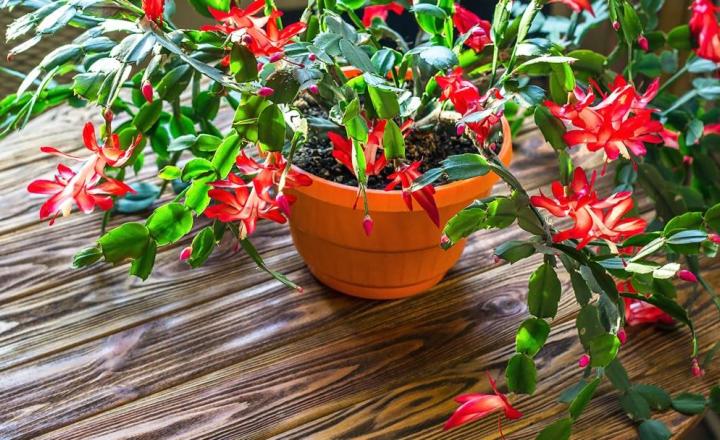How to properly care for a plant at home
The Decembrist loves water, which makes it different from other cacti. You need to water it with warm liquid, and you can also place the flower on a tray with damp pebbles. It is better to grow it on the eastern windows. In summer, the flower can be taken out into the fresh air, and in winter, the temperature in the room can be kept at least 10-11 degrees Celsius. Avoid exposure to direct sunlight and do not turn it only one side to the light, otherwise the plant will be "one-sided".
The Decembrist is susceptible to fungal and bacterial diseases, so he needs to be examined periodically. The flower may be damaged by a spider mite, scabbard and mealybug. At the first signs of the disease, it is necessary to start treatment with drugs.
Lighting, temperature control
The Decembrist cannot be kept under the scorching rays of the sun; it will be much more comfortable for him in diffused lighting. It is best to place it on the east or north-east windows. If you can place the zygocactus only on the south side, then the plant will need to be shaded to avoid sunburn.
For flowering, the Decembrist needs the day to become short, this period falls on the winter. The temperature in the room during this time drops to 10-15 degrees. It often happens that only the part of the flower that was facing the cold window blooms. But it is also impossible to reduce the temperature too much, the plant does not tolerate frost and may die. In summer, the Decembrist feels great at 18-24 degrees Celsius.
Soil requirements
First of all, you need to carefully consider the choice of soil for the pot. The Decembrist loves light, nutritious soil with good drainage. The soil should be easy to allow moisture and air to pass through. Often used for these purposes a mixture of peat, leaf earth and sand. You can also add humus and sod to the soil. The best soil for the Decembrist is slightly acidic. You can use ready-made succulent potting mix.
Before planting a flower, the ground must be disinfected. For these purposes, crushed coal can be used. For greater airiness of the soil, small pieces of tree bark and perlite are added to it.
Watering, feeding
The plant is watered all year round. Although a cactus can store a certain amount of water in its leaves, it will not last for a long time. Decembrists naturally grow in tropical rainforests and they need liquid. Drought will lead to the death of the roots and the death of the plant.
Watering should be constant but moderate. With prolonged waterlogging, the roots of the plant can rot. Water the flower after the top earthen layer has dried. You can place the pot on a pallet with damp pebbles.
From the beginning of September, the Decembrists begin to feed with potash fertilizers and stop after the beginning of flowering. After the buds have fallen off, the plant rests on nutritional supplements. Starting from March-April, the tropical cactus is fed with complex fertilizer for potted flowers.
How to cut a Decembrist?
June is the best time for the circumcision of the Decembrist. In order to form a beautiful crown, shoots that grow incorrectly are removed. After the procedure, the plants bloom more intensively and look better. It is better not to cut the shoots, but to twist them off, so less damage is done to the flower.
Transfer
The young Decembrist needs a transplant once a year, in the spring. The pot is chosen not too large, since it is easy to water the plant in it. Adult Decembrists are transplanted every 3-5 years.
It is best to choose a pot that is short but wide. It is forbidden to transplant the plant during flowering, this will negatively affect its health. The container is filled by a third with drainage, the rest is occupied by the soil layer, which is previously disinfected with crushed coal.
When replanting, loosen the soil around the edges of the pot and remove the plant along with the soil. Slightly clean the root system of soil residues and bury the Decembrist in new soil. Water the flower abundantly after transplanting.
Post-flowering care
After flowering, the Decembrist is moved to a cool place and slightly limited in watering. The room should be protected from direct sunlight, it is better if there is partial shade in it. At the end of March, the flower is transferred back and the flow of moisture is increased. They also begin to apply mineral fertilizers.
Caring for the Decembrist at home
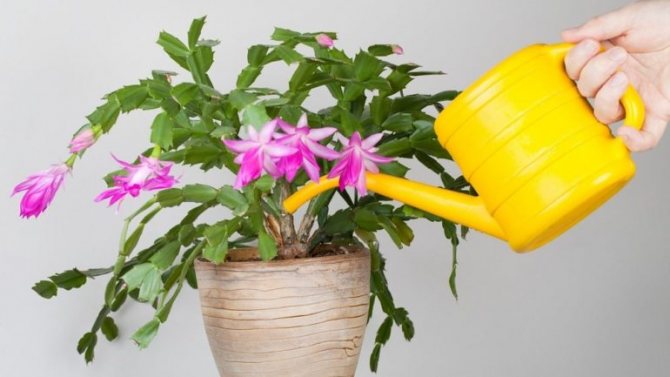
This indoor flower is quite unpretentious to care for. But the observance of important rules and principles will determine how intensively the plant will bloom and how long your green "pet" will stand on the windowsill. Let's dwell on the aspects of care in more detail.
Lighting
Epiphytic cactus prefers bright and diffused lighting at the same time. Optimal conditions are places next to windows facing east or northeast. But the south side is not considered an ideal solution. But if it is not possible to achieve a diffused light regime, then the flower is shaded.
During the period of budding and active flowering, the container with the Schlumberger should not be turned or even moved. Otherwise, the plant will get rid of the flowers. But when it retires, then you can and should regularly unfold the pot so that the stems turn green evenly.
Humidity and temperature
The Decembrist is extremely tenacious and unpretentious to the temperature regime. An indoor plant without special physical and moral losses will endure both 35-degree heat and lowering the temperature to + 2. However, there are also optimal indicators of this parameter - + 18-25 degrees. It is under such conditions that the flower feels especially comfortable.
In order for the zygocactus to bloom especially intensively and delight others with bright greenery, experts advise placing it in a cooler place in September-November (no higher than +16 degrees). But just before flowering, it is moved to a warm place to form beautiful and healthy buds.
A tropical guest is not afraid of drafts. Therefore, in the summer months, the pot with the zygocactus can be taken out to the open balcony for airing, or even taken with you to the dacha. The only condition is not to expose the flower to direct sunlight.
Schlumberger, unlike "classic" cacti, loves high humidity. That is why the plant needs to constantly arrange a shower from a spray bottle: in hot weather - several times a week, in winter - 1-2 times every 30 days.
Watering
Proper care of the zygocactus also implies adherence to the watering regime. The latter is conditionally divided into 3 periods, each of which differs in certain nuances and aspects.
- Bloom. During these months (December-February), the plant requires frequent but moderate watering. You can understand that the flower wants to "drink" by drying out the soil by 1-3 centimeters in depth. At the same time, it is absolutely impossible to fill the pot, otherwise the cactus will simply begin to rot, especially if the room is cool enough.
- Before and after flowering. To start laying the buds, the intensity of watering is reduced. Some gardeners generally sharply limit the moisture of the flower in order to redirect its forces not to stemming, but to budding. In the period after flowering (March-early summer), you should adhere to the same watering regime as during flowering.
- Hot season. In the summer, the plant retires, therefore, water it as the soil substrate is almost completely dry. But we should not forget about spraying, or rather, about the soul.To do this, the pot is transferred to the bathroom and the jets are directed directly to the leaves and stems. The ground at this moment should be covered with a plastic bag.
Do not water the delicate plant tap water. It contains a huge amount of chlorine and calcium compounds that harm the home cactus. Take care of using settled boiled water for irrigation.
Top dressing
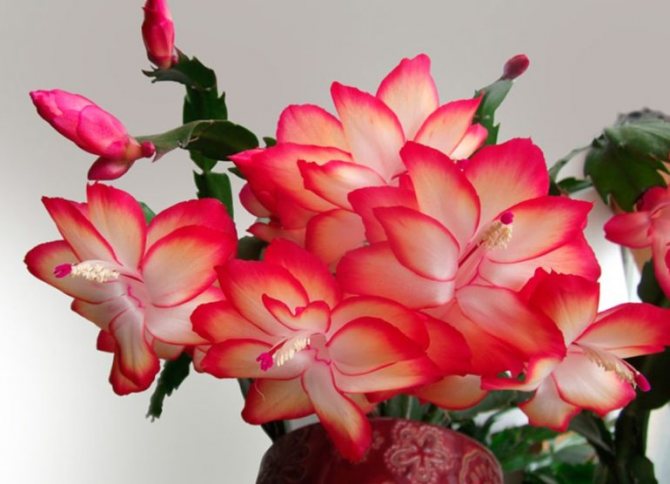
Under natural conditions, the zygocactus receives most of its nutrients from the tree on which it grows. And this is a rather modest "diet", so it is considered that the Decembrist is indifferent to vitamin and mineral supplements.
Nevertheless, it is possible and necessary to feed a Schlumberger, if, of course, you want to enjoy a longer flowering. To do this, it is worth purchasing cactus fertilizers containing nitrogen, potassium and phosphorus compounds in certain proportions.
From March to August, when the Decembrist fades and goes on to intensive stemming, the plant is fed twice a month.
Please note that the dosage must be taken 2 times less than what is written in the instructions. After all, a Christmas tree, as we have already said, is different from its thorny counterparts.
Pot and soil selection
When transplanting, you will need to choose a new container and use fresh soil, since the old one is most likely salted and is not suitable for further growing the Decembrist. The new pot should be no more than 2 centimeters wider than the old one and by the same amount deeper. This space will be enough for a year so that the flower can actively grow and grow the root system. The container can be made of plastic or clay, the main thing is that there are drainage holes at the bottom.
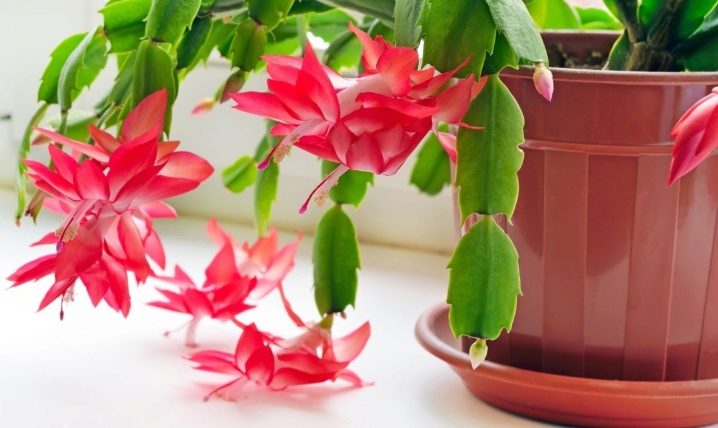
A container that is too large will hold a lot of water, which can cause root rot. In a small Decembrist will stop growing. Before replanting the plant, you will need to disinfect the pot by soaking it in a solution of 1 part chlorine bleach and 9 parts water. After that, the container must be well rinsed with clean water.
As for the soil, special requirements are imposed on it: it must be light, nutritious, acidic (with a pH of 5.5-6). High-quality drainage is a prerequisite for keeping most indoor plants, and the Decembrist was no exception. If the soil is purchased ready-made, it is best to buy a universal type of soil and specialized for cacti, and then mix them in a 1: 1 ratio. If you use only one type of soil, the flower will lack nutrients.
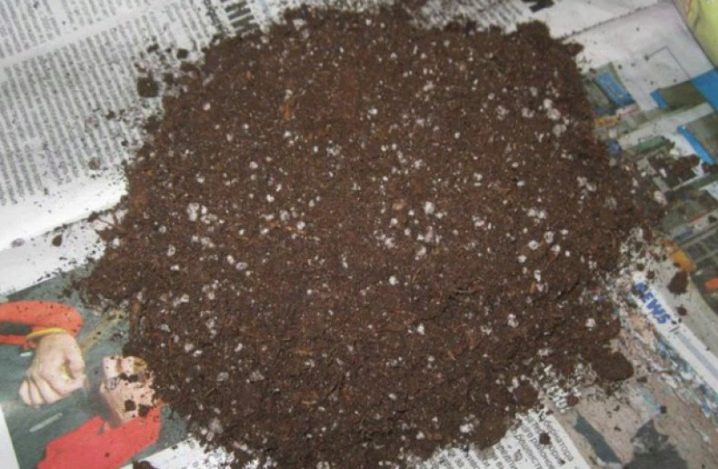
The plant is very susceptible to bacterial and fungal infections, so the soil should be moderately moist, preferably loose. As drainage, you can use:
- pebbles;
- sphagnum;
- crushed stone;
- shards of clay;
- gravel.
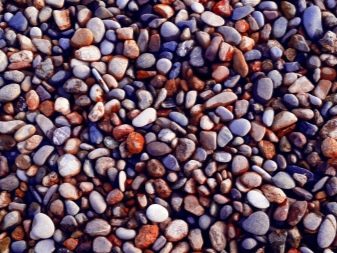

A crumb of foam provides additional protection to the roots from hypothermia, but it cannot be used in large quantities, since it will contain water, not let it pass. Additives such as perlite and vermiculite are no less in demand as drainage. Any drainage should be one third of the volume available in the container.

You can also make potting soil yourself, there are several recipes for this. A soil made from mixed in equal proportions of leafy earth, coarse sand, peat and charcoal is excellent. Will not damage turf or humus, which will be an excellent nutrient base. In another embodiment, the soil ideal for a flower is collected from a part of fertile soil, the same amount of sand and two parts of peat. Perlite gives the compost looseness.

How to care for a Decembrist flower at home
Schlumberger is an unusual type of cactus. It blooms in winter, does not like high temperatures and bright sunlight. Therefore, the conditions for its maintenance are fundamentally different from the conditions for growing other cacti and succulents.There are certain rules for how to care for Decembrist so that it blooms and has lush and healthy stems.
Lush bloom depends on conditions content
Growth temperature conditions, location determination
The Decembrist, like other representatives of zygocactus, cannot stand exposure to direct sunlight. However, the plant needs good lighting. Therefore, for the location of the Decembrist, it is preferable to use window sills on the east side of the room. In summer, the flower can be placed outdoors or on a balcony.
Temperature conditions should be chosen depending on the periods of plant development. Active growth (vegetation) occurs during the warmer season - from April to September. During the growing season, the flower needs free access to oxygen, the ideal temperature for it will be + 20 ° C.
In the fall, Schlumberger freezes to prepare for flowering. Incorrect content is the reason why the Decembrist does not bloom at home. For a comfortable stay, the flower needs to create conditions of coolness and low humidity. If in the summer the plant was kept in the air, then in the fall it can be left in the same place, keeping the temperature not lower than + 12 ° C, the temperature in winter - from + 16 ° C to + 22 ° C.
What land is needed for the Decembrist
Before planting a Decembrist, you should prepare high-quality soil for it. Schlumberger is a representative of the epiphyte species that naturally grow on other plants. Accordingly, the soil must freely pass moisture and air. The soil mixture is made up of leafy earth and sand in equal parts. For better flower nutrition, peat or charcoal is added to the mixture. Packaged soil for cacti, sold in stores, will not work, since it contains an excess amount of peat.
Soil for cacti is oversaturated with peat
Decembrist transplant rules at home
How to transplant a Decembrist at home so as not to harm the flower? It is recommended to do this after flowering in early spring. For the first few years, shoots are transplanted every spring, then every 3 years. The new pot should be 2 cm larger than the old one. One third of it is filled with drainage. To improve moisture permeability, fine expanded clay is added to the soil mixture. A tall pot is not required for Schlumberger, as it has superficial roots.
How to water the Decembrist, depending on the season
Unlike other cacti that can be watered infrequently, Schlumberger needs regular watering. However, you cannot fill the flower, as its roots can rot. Water it with soft water at room temperature.
Spraying removes dust on the stems
During the growing season, watering is needed moderate. The Decembrist must be regularly sprayed with warm water so that the plant feeds on moisture, and the stems are cleaned of dust.
Catalog of indoor flowers with photos and their names. In a special publication of our portal, we will tell you in detail about indoor flowers. You will learn about the types of indoor flowers, fruit indoor flowers and see the photo gallery.
Possible problems with the flower
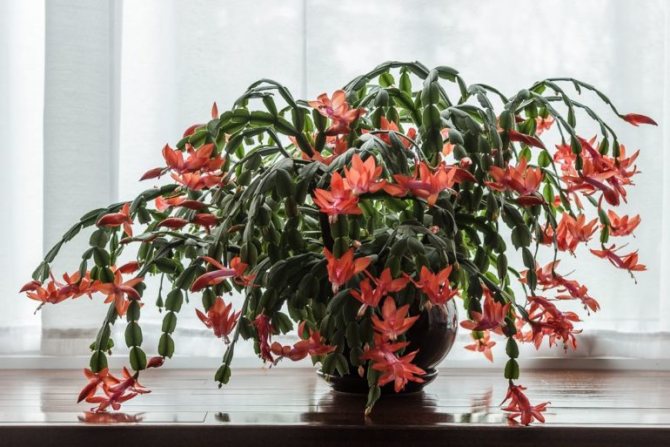
The Decembrist flower usually does not cause much inconvenience to gardeners. But it is impossible to exclude the occurrence of some problematic situations associated with the growth of leaves and stems, as well as flowering. We have already talked about something, something should be said additionally.
Table 1. Problems with the cultivation of zygocactus.
Problem
Causes
Solution
The flower withers
The pot is next to a hot radiator, which causes the leaves to wrinkle. Another likely cause is over-watering.
It is necessary to rearrange the pot to a cooler place (however, if you do this during flowering, the flowers will disappear). You should also reduce the intensity of watering, replacing it with abundant spraying.
Leaves and buds fall
The main reason is over-watering.
It is necessary to reduce the intensity of watering
After a while, you need to remove the flower from the container, remove the rotten roots and transplant it into new soil.
Blush plant stems and leaves
The main reasons: excessive watering, improperly selected top dressing, direct sunlight, drafts.
It is important to exclude all of the listed provoking factors. You should also keep the Decembrist in a cool room, away from drafts and bright sunlight.
Plant growth has slowed down
The main reasons: lack of moisture, untimely application of top dressing to the soil, too bright light.
Since the beginning of spring and until the end of summer you need to apply special fertilizers to the soil
You should also regularly water, spray and wash the leaves and stems with warm, settled water.

